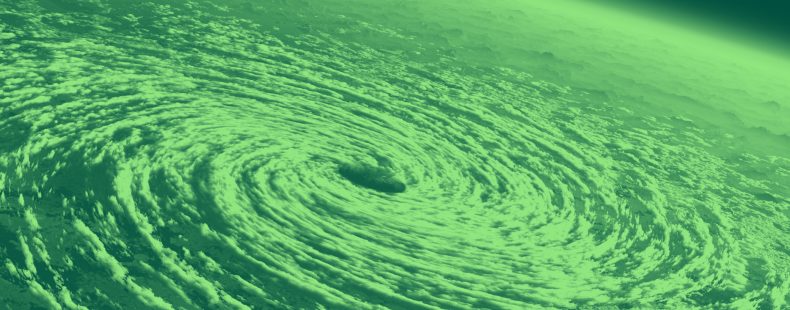Cyclone, hurricane, and typhoon are all terms for big storms. Are they all the same thing? What’s the difference?
Join us on this whirlwind tour as we answer these questions and more:
- What’s the difference between a cyclone, a hurricane, and a typhoon?
- What’s the difference between a tropical cyclone, a tropical depression, and a tropical storm?
- Why are some tropical cyclones called hurricanes and others called typhoons?
- What’s the difference between a hurricane and a tornado?
⚡ Quick summary
The word cyclone is a general term for a large storm system, the most severe kind of which is called a tropical cyclone. The words hurricane and typhoon are simply different names for tropical cyclones. Tropical cyclones that originate in the West (mostly over the Atlantic Ocean and Gulf of Mexico) are called hurricanes. Tropical cyclones that originate in the East (mostly over the western Pacific and northern Indian Ocean) are called typhoons. A tornado is different altogether—it’s a funnel cloud that forms from a storm over land (sometimes as part of a hurricane). Tornadoes are much smaller in scale than hurricanes.
What is a cyclone?
A cyclone is, technically speaking, “a large-scale, atmospheric wind-and-pressure system characterized by low pressure at its center and by circular wind motion.”
Because these systems generally produce clouds and precipitation, the word cyclone is often used generally to refer to a big storm.
The word cyclone comes from the Greek kyklôn, meaning “revolving.”
Tropical cyclone vs. tropical depression vs. tropical storm
When cyclones form around the region known as the tropics, they are called tropical cyclones. Tropical cyclones are classified based on their strength, largely based on the speed of the winds they produce. They may start as tropical depressions. If they become more severe, they are called tropical storms.
What’s the difference between a hurricane and a typhoon?
The most severe tropical cyclones—those with winds of 64 knots (74 mph or 119 km/h) or more—are called hurricanes or typhoons. Which term is used depends on where the storm occurs.
The name hurricane is used for tropical cyclones of the Atlantic Ocean, Caribbean Sea, Gulf of Mexico, and the central northern and eastern Pacific Ocean.
The name typhoon is used for tropical cyclones of the western and northwestern Pacific Ocean and the northern Indian Ocean.
In other places, the generic term tropical cyclone is used.
Despite the naming differences, they’re all the same thing in terms of how they’re formed and how they behave and function.
Discover more tempestuous weather words for all kinds of climate.
Hurricanes and typhoons are also further separated into different levels of intensity. The biggest hurricanes with the strongest winds—the ones you’re most likely to hear about when they’re forecasted to make landfall—are classified as major hurricanes (these include those labeled as Category 3, 4, and 5 hurricanes). Typhoons with the highest wind speeds are classified as super typhoons.
Regardless of their severity or what they’re called, cyclones rotate counterclockwise in the Northern Hemisphere and clockwise in the Southern Hemisphere.
The word hurricane comes to English via the Spanish huracán and the Portuguese furacão, from the Taíno huracán and furacán—all words for ferocious storms. The word typhoon is an alteration of earlier words such as the Arabic ṭūfān, meaning “hurricane” or “deluge,” and the Chinese taaî fung, meaning “great wind.” It may ultimately come from the Greek tȳphôn, meaning “violent wind.”
Hurricane vs. tornado
Like hurricanes, tornadoes involve the rotating movement of air. But a hurricane isn’t just a really big tornado. Simply speaking, a hurricane is a storm—or, more precisely, a storm system that’s often made up of multiple thunderstorms. A tornado, on the other hand, could be described as a single element of a single storm.
In technical terms, a tornado is “a system of atmospheric circulation, characterized by a long, funnel-shaped cloud extending toward the ground and made visible by condensation and debris.” (In other words, the spinning air funnel we know as a tornado is invisible until it starts gathering up water vapor, dirt, and other debris.)
Unlike hurricanes, tornadoes are exclusive to land. Hurricanes are essentially massive, spinning formations of multiple thunderstorms, while tornadoes are formed from a wind vortex from the hot, high-pressure wind of a single thunderstorm over land. Tornadoes can form from the thunderstorms that make up a hurricane, but they more commonly form from single thunderstorms.
Hurricanes are much, much bigger than tornadoes. The largest tornadoes are about 2 miles (3.2 km) in diameter, and average ones are often much smaller. In contrast, the average hurricane is about 300 miles (482 km) in diameter.
Learn more about the language of climate change and how these big storms fit in.
To be considered a hurricane, a storm system must have wind speeds of at least 64 knots (74 mph or 119 km/h). Tornadoes produce wind speeds of at least 34 knots (40 mph). Hurricanes and tornadoes are both known for how dangerous and destructive they can be. Tornadoes can destroy everything in their path, but they’re relatively small and short-lived. Hurricanes are capable of even more widespread destruction due to their size and their ability to move across entire regions and last for several days, causing destruction with both high winds and massive amounts of rainfall.
Cyclone vs. tornado
In casual use, the word cyclone is sometimes used to refer to a tornado, but it is not used this way in scientific contexts.
Cyclones vs. hurricanes vs. typhoons vs. tornadoes
To recap:
- Cyclones are massive, rotating storm systems.
- Those that form in the tropics are called tropical cyclones.
- Less severe tropical cyclones are called tropical depressions.
- More severe tropical cyclones are called tropical storms.
- The most severe tropical cyclones are called either hurricanes or typhoons depending on where they occur.
- Tornadoes are rotating funnel clouds that only form over land, and they’re much, much smaller than hurricanes.














